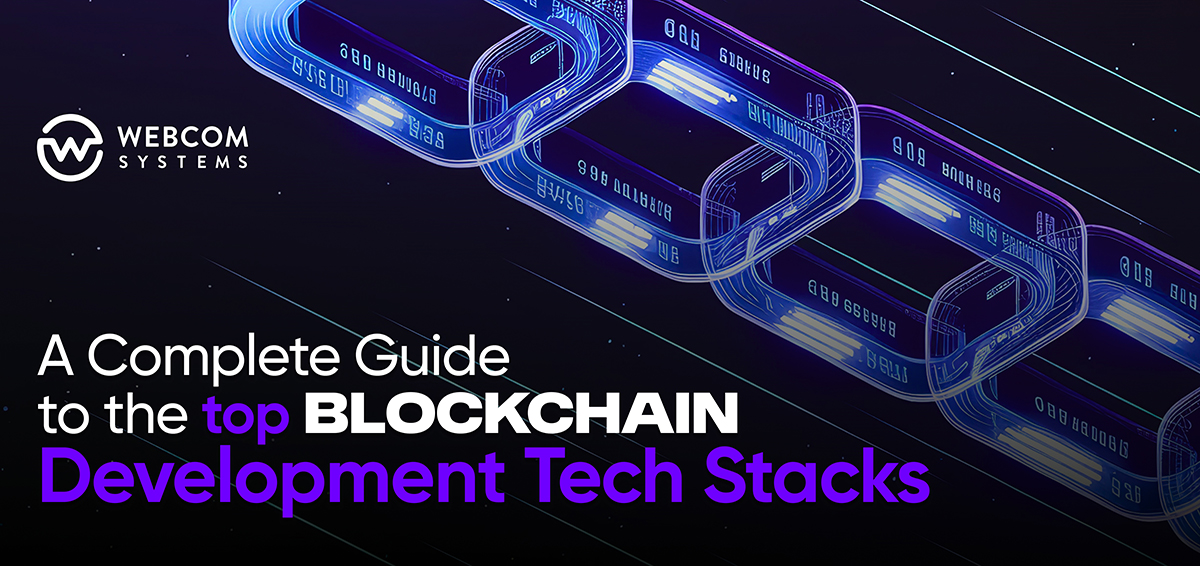Blockchain is the leading transformative technology that is altering how we view transparency, security, and privacy in the digital world. It presents decentralized, immutable, and reliable solutions that benefit various industries like finance, retail, healthcare, logistics, and much more. Consequently, global adoption of blockchain technology is rising rapidly, with the market projected to grow to USD 1.42 billion by 2032.
However, developing a decentralized solution is far from “simple.” It requires various tools and frameworks that work together to power a robust blockchain platform and deliver it its desired functionality. This technology stack is used to develop the entire blockchain platform, from the basic infrastructure to the consensus algorithms, network communication, and decentralized applications.
As a leading blockchain development company, we at Webcom Systems understand the intricacies of blockchain development and the appropriate technology stack for creating secure blockchain platforms. In this guide, we outline the top blockchain development technologies and tools leveraged by our blockchain experts. Every tool and technology mentioned in this blockchain technology stack guide is critical for engineering robust blockchain applications for your enterprise. So, make sure to read till the end for a deeper insight!
Best Tech Stack for Blockchain Development
Blockchain architecture can be divided into 5 layers, each constituting a distinct blockchain development tech stack. Collectively, these tech stacks form the backbone of any modern blockchain system. Let’s explore these technologies in detail.
Layer 1: Networks
Layer 1 constitutes blockchain networks that serve as the primary component of the entire blockchain solution. They provide the most basic feature, which is decentralization. Moreover, these networks validate all blockchain transactions and maintain the distributed ledger. All technologies and tools used in this layer ensure the network can operate independently, without the need for intermediaries. Both layer-1 and layer-2 programmable blockchains are employed in modern blockchain systems. Layer-1 blockchains act as the core layer, while layer-2 enhances the scalability and efficiency of the blockchain network.
Layer 1 Blockchains:
- Ethereum: Leading platform with smart contract functionality.
- BNB Chain: EVM-compatible blockchain for scalable applications.
- Solana: High-performance blockchain with fast transaction speeds.
- Avalanche: Open-source platform supporting dApps and smart contracts.
- Polkadot: Nominated Proof-of-Stake blockchain
- Cardano: Public and decentralized blockchain platform
- NEAR: Open-source blockchain designed for scalability
- Flow: Optimized for Web3 apps and the open metaverse
Layer 2 Blockchains
- Polygon: Proof-of-Stake (PoS)-based blockchain for Ethereum scaling.
- Arbitrum: Provides higher throughput and lower transaction fees.
- Optimism: Built on the OP Stack, part of the Superchain ecosystem.
- Hermez: Open-source ZK-Rollup for systematic Layer 2 scaling.
- zkSync: High-performance rollups and validiums for scalability.
- StarkNet: Leading Validity Rollup using STARK-based proofs.
Blockchain developers choose the blockchain network as per the network requirement and employ any or a set of the above blockchains to create custom blockchains.
Layer 2: Nodes
Blockchain nodes work together to approve transactions and link blocks and maintain the integrity and continuity of the blockchain. The way these nodes are distributed across the network directly impacts as well as sets the level of decentralization.
Further, there are different types of nodes, mainly: Full, Light, and Validator nodes. The first one records the complete transaction history of the blockchain, while the light one only stores the important data, such as block headers. Lastly, the Validator nodes use different consensus mechanisms to validate the transactions. Depending on the type of blockchain networks, it can support consensus mechanisms like Proof of Work (PoW), Proof of Stake (PoS), Delegated Proof of Stake (DPoS), etc.
Managing the nodes of blockchain networks may seem easy, but it involves ongoing work that can be quite complex and resource-intensive. That’s why there are many specialized node providers in the market that assist with this, such as Infura, Alchemy, QuickNode, Chainstack, and more.
Layer 3: APIs
As with any modern application, blockchain platforms often need to integrate with external systems for enhanced functionality, and this is where APIs (application programming interfaces) are found useful. Simple API integrations help blockchain developers cut hours of work and focus on building features rather than managing raw blockchain data.
Here is the list of some of the most trusted Blockchain APIs:
The Graph: Allows efficient blockchain data indexing
Blockchair API: Offers transaction and wallet tracking
Covalent: Improves transparency and asset tracking
Etherscan API: Provides Ethereum transaction and wallet data
While all the above APIs are useful, Moralis stands out as a comprehensive Web3 API provider. Its developer-friendly features make it simple to create cross-chain Dapps using a single framework.
Layer 4: Web3 and Web2 Dev Tools and Platforms
Layer 4 represents the presentation layer, which can also be viewed as a developer experience layer, as it is where most blockchain development occurs. This layer includes platforms, Web3 native libraries, software development kits (SDKs), developer environments, frameworks, file storage solutions (such as IPFS), and more. These blockchain development frameworks facilitate the coding and deployment of smart contracts and other front-end applications.
Here’s the list of common components:
Smart Contract Languages:
- Solidity
- Vyper
- RustFrameworks:
- Hardhat
- Truffle
- Foundry
Testing & Deployment Tools:
- Ganache
- Remix
- Tenderly
Wallet Integration & Frontend SDKs:
- Web3.js
- Ethers.js
- WalletConnect
- MetaMask SDK
Layer 5: Dapps
This is the topmost layer in the blockchain tech stack that directly interacts with end users. It gives purpose to all the underlying layers by enabling decentralized applications (DApps) that serve real-world use cases. These applications use smart contracts on the backend to execute logic and automate operations on the network without centralized control.
Different Dapp Categories
- DeFi
- NFTs & Gaming
- DAOs
- Social & Web3 Identity
Dapps are developed in stages, beginning with simple interactions such as wallet integrations and progressing to fully decentralized systems featuring governance, tokenomics, and cross-chain functionality. As previously stated, this layer interacts with users, so it is critical to provide high-quality user interfaces (UI) and seamless user experiences (UX).
Wrapping Up
In conclusion, employing the right blockchain technology stack is essential for creating robust blockchain applications and solutions. However, excelling in this industry requires ongoing research, adaptation, and evolution over time. While we have mentioned the main technologies and top tools for blockchain development, our team of blockchain experts continuously searches for new innovations and optimizations to stay updated at all times. If you are looking to build a blockchain solution for your business, we can assist you with it. We provide a range of blockchain development services, ranging from blockchain consultation to dApp development, smart contract development, and much more. Get in touch to discuss your project.
Recommended Read: Why Is Blockchain Development Crucial for Financial Applications?




